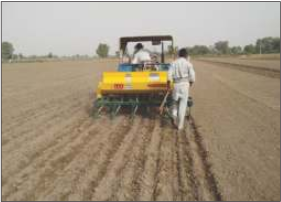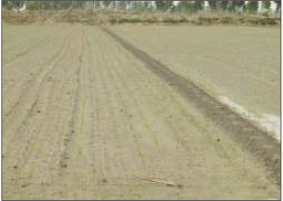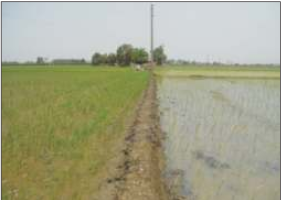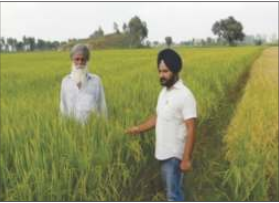Direct seeded rice for promoting water use efficiency
Direct seeded rice for promoting water use efficiency
Climate vulnerability : Drought
Existing practice
In the North-Western Indo-Gangetic Plains (IGP), transplanted rice is predominantly cultivated. Transplanting requires at least 25 ha-cm of water for puddling operation, which creates a dense clay layer in the sub-soil to prevent seepage losses. The crop requires about 130 ± 10 ha-cm of irrigation in addition to adoption of suitable variety and application of recommended dose of fertilizers to realize yield levels of about 6 ± 2 t/ha. Generally, about 40% of all irrigation water goes to paddy cultivation in the region. It is estimated that flooded rice fields produce about 10% of global methane emissions. Also, injudicious use of nitrogenous fertilizers is a common feature in paddy cultivation which is a source of nitrous oxide emissions. In Punjab, farmers generally take up transplanting of coarse rice. The current practice of excessive exploitation of ground water has led to a decline in the quality of natural resources i.e. land and water.
Resilient practice / technology
Researchers have developed suitable direct seeding alternatives to transplanted paddy. In direct seeded rice (DSR) cultivation, raising of nursery for transplantation is done away with. Farmer can avoid the major problem faced in Punjab i.e., labour shortage for transplanting due to peak demand. In case of delay in monsoon or shortage of water, DSR gives the farmer flexibility to take up direct sowing of paddy with a suitable duration variety to fit into the left over season. This allows timely sowing of the succeeding rabi wheat. Direct sown rice consumes relatively less water compared to transplanted flooded rice. Energy demand for pumping of irrigation water is also less and saving can be much higher during deficit rainfall situations compared to transplanted rice. Direct sowing can be practiced for cultivating both coarse rice and basmati rice wherever feasible in the North-West IGP region.
Direct seeded rice in un-puddled field to cope with water shortages : Direct seeding of drought tolerant varieties of rice in dry soil is done in June with pre-emergence herbicide application (pendimethalin 1 kg/ha) under sufficient soil moisture conditions followed by a post-emergence herbicide application (bispyribac sodium 25g/ha) at 25-35 days after sowing or hand weeding at 35-45 days after sowing to effectively manage weed problem. Direct seeding in moist field with receipt of rains in June or by using ground water along with the application of pre-emergence herbicide is another option attempted. Control of weeds by use of glyphosate followed by zero till direct seeding of rice after one day of herbicide use is also practiced. In Bihar, direct seeding of medium duration varieties (125 days) can be done during second fortnight of July in midlands followed by a post-emergence herbicide application. In uplands, direct seeding of rice can be taken up with the onset of monsoon rains. Direct seeding of rice is done with a zero till drill. The quantity of seed required is 20-25 kg/ha compared to transplanted paddy which required 60-80 kg/ha.
Impact of direct seeded rice
Gurpreet Singh of Pindi Blochan village, Faridkot district in Punjab practices rice-wheat cropping system in about 32 acres (12 own and 20 acres on lease). Initially he could not take up direct seeding of coarse rice due to rains. For the first time he cultivated Basmati rice in 5 acres adopting direct seeding practice and traditional transplanted course rice in another 15 acres. Average yield of direct seeded basmati rice was 51 q/ha while that of transplanted coarse rice was 46.3 q/ha. With DSR he saved about Rs 3000 - 4000 per hectare in labour cost and irrigation water (less by 7 irrigations). However, he had to spend on herbicide applications. In 2013-14 season, he doubled the area under direct seeded basmati rice.
DSR with reduced tillage is an efficient resource conservation technology that holds great promise in the Indo-Gangetic Plains in view of the following advantages:
- Saving in water up to 25% in DSR
- Saving in energy up to 27% of diesel as pumping energy is saved for field preparation, nursery raising, puddling and reduced frequency of applying irrigation water
- Saving of 35 to 40 man days / ha
- Enhanced fertilizer use efficiency due to placement of fertilizer in the root zone
- Early maturity of crops by 7-10 days helps in timely sowing of succeeding crops
- Reduction in methane emissions and global warming potential
- Little disturbance to soil structure
- Enhanced system productivity
Scope for upscaling
Direct seeded rice is relatively more popular in the rainfed rice growing states like Chhattisgarh. There is scope to upscale the technology in the north-west Indo-gangetic plains to promote higher water use efficiency and also in rainfed rice growing areas in Odisha and Andhra Pradesh.




Source: Smart Practices and Technologies for Climate Resilient Agriculture
Last Modified : 2/12/2020
This topic provides information about Community pa...
This topic provides information about Crop diversi...
This topic provides information about Community ta...
This topic provides information about Check dams f...
